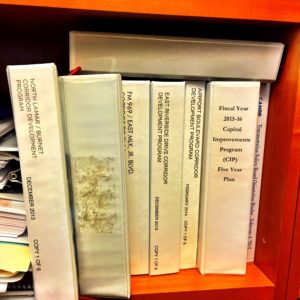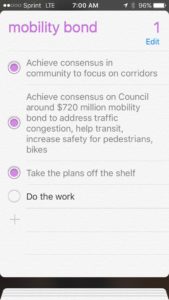Today the Austin City Council approved an ordinance on third reading the $720-million Smart Corridor mobility bond that contains transportation projects that would address traffic congestion, improve public transit, and increase safety and convenience for pedestrians and bikes.
 “Today the Council took an important step to address traffic congestion and our other mobility challenges. These corridor plans have been sitting on the shelf long enough. It’s time to do the work,” said Mayor Steve Adler. “The Smart Corridor mobility bond reflects the widespread support in the community and on this Council to address traffic congestion, improve transit, increase safety, and build walkable neighborhoods. We have our congestion level in Austin because we have chosen not to invest in our infrastructure. This is a down payment on a better future for Austin’s traffic.”
“Today the Council took an important step to address traffic congestion and our other mobility challenges. These corridor plans have been sitting on the shelf long enough. It’s time to do the work,” said Mayor Steve Adler. “The Smart Corridor mobility bond reflects the widespread support in the community and on this Council to address traffic congestion, improve transit, increase safety, and build walkable neighborhoods. We have our congestion level in Austin because we have chosen not to invest in our infrastructure. This is a down payment on a better future for Austin’s traffic.”
Since 1998, Austin voters have approved mobility bonds totaling $628 million.
The mobility bond includes work on North and South Lamar Boulevard, Burnet Road, Riverside Drive, Airport Boulevard, MLK/FM 969, Guadalupe Street, and Slaughter and/or William Cannon. According to census data, 26%-29% of Austinites live within half a mile of these corridors. Previous mobility bonds paid millions of dollars to complete these studies that involved extensive public input.
In addition, the mobility bond would fund future corridor plans on other sections of North Lamar, South Lamar, MLK, and Guadalupe, as well as E. Colony Loop Road, Manchaca, and S. Pleasant Valley Road.
Also, the mobility bond includes proposed improvements to “pain points” on regional roads, including the Loop 360-Westlake Drive intersection, Spicewood Springs Road, the Old Bee Caves Road Bridge, Anderson Mill Road, the 620/2222 intersection, and Parmer Lane.
Finally, the mobility bond includes major investments in active transportation, including $37.5 million for the Sidewalk Master Plan, $27.5 million to provide safe sidewalks to schools, $26 million for urban trails, $20 million toward the Bicycle Master Plan, and $15 million toward the Vision Zero Action Plan to reduce pedestrian traffic fatalities.
Turning the old state highways (such as North Lamar, which used to be the Dallas Highway) into Smart Corridors entails making specific improvements that will increase the capacity and efficiency of these roads. These improvements include:
- Turn lanes and raised medians, so traffic is not blocked by people waiting to turn
- Bus pullouts and queue jumps, so stopped buses do not block traffic – and so buses get
 back into the lane ahead of traffic
back into the lane ahead of traffic - Protected bike lanes, so biking is safer and more convenient, and different modes of traffic can move at appropriate speeds safely
- Smart signalization, so traffic lights are timed automatically in real time.
The corridor plans already completed after undergoing thorough public review predict the following improvements to traffic congestion:
- South Lamar: Turning South Lamar into a Smart Corridor would have a profound effect on traffic congestion. If we make the long-term improvements included in the Smart Corridor plan, wait times at intersections during morning rush hour on South Lamar would improve 61%. If we do nothing, wait times at intersections in the mornings will increase 216%. In the evening rush hour, wait times at intersections will decrease 51% if we do the long-term projects. If we do nothing, evening rush hour delays will increase 113%.
- North Lamar: If we turn North Lamar Boulevard into a Smart Corridor, morning delays at intersections would decrease 48%, and evening delays at intersections would decrease 49%.
- Burnet Road: If we do the long-term work on Burnet Road, morning delays at intersections would decrease 11% and afternoon rush hour delays would go down 27%.
- Airport Boulevard: If we do the long-term projects in the Smart Corridor plan, delays at intersections during your morning commute would decrease 10%; if we do nothing, delays will increase 40%. In evening rush hour, wait times at intersections would decrease 20%; if we do nothing, wait times at those same intersections will increase 40%.
The bond will be paid for with an increase in city property taxes. The owner of an average-priced home of $250,000 will see an increase of $4.67 a month.
| 2016 Mobility Bond | |||||||||
| CORRIDOR PLANS | |||||||||
| North Lamar Blvd | |||||||||
| South Lamar Blvd | |||||||||
| Burnet Road | |||||||||
| Riverside Drive | |||||||||
| Airport Blvd | |||||||||
| MLK/FM969 | |||||||||
| Guadalupe Street | |||||||||
| Slaughter and/or William Cannon | |||||||||
| TOTAL | $477,500,000 | ||||||||
| FUTURE CORRIDOR PLANS | |||||||||
| North Lamar/Guadalupe | |||||||||
| East and West Rundberg | |||||||||
| E. Colony Loop Road | |||||||||
| MLK | |||||||||
| South Congress | |||||||||
| Manchaca | |||||||||
| S. Pleasant Valley Rd. | |||||||||
| TOTAL | $4,500,000 | ||||||||
| TOTAL CORRIDORS | $482,000,000 | ||||||||
| REGIONAL MOBILITY | |||||||||
| Loop 360 (Westlake Drive Intersection) | $46,000,000 | ||||||||
| Spicewood Springs Road | $17,000,000 | ||||||||
| Old Bee Caves Road Bridge | $8,000,000 | ||||||||
| Anderson Mill Road | $5,500,000 | ||||||||
| 620/2222 Intersection | $7,500,000 | ||||||||
| Parmer Lane | $17,000,000 | ||||||||
| TOTAL | $101,000,000 | ||||||||
| LOCAL MOBILITY | |||||||||
| SAFETY AND ACTIVE TRANSPORTATION | |||||||||
| Sidewalk Master Plan | $37,500,000 | ||||||||
| Safe Routes To School Sidewalks | $27,500,000 | ||||||||
| Urban Trail Master Plan | $26,000,000 | ||||||||
| Bicycle Master Plan | $20,000,000 | ||||||||
| Vision Zero Action Plan | $15,000,000 | ||||||||
| SUBSTANDARD ROADWAYS/CAPITAL RENEWAL | |||||||||
| Falwell Lane | $6,000,000 | ||||||||
| Wm Cannon Railroad Overpass Bridge | $1,000,000 | ||||||||
| Cooper Lane | $500,000 | ||||||||
| Ross Road | $500,000 | ||||||||
| Circle S Drive | $500,000 | ||||||||
| Rutledge Spur | $500,000 | ||||||||
| Davis Lane | $500,000 | ||||||||
| Latta Drive/Brush Country | $500,000 | ||||||||
| Johnny Morris Road | $500,000 | ||||||||
| Brodie Lane | $500,000 | ||||||||
| TOTAL LOCAL MOBILITY | $137,000,000 | ||||||||
| TOTAL 2016 MOBILITY BOND PACKAGE | $720,000,000 | ||||||||
-30-
